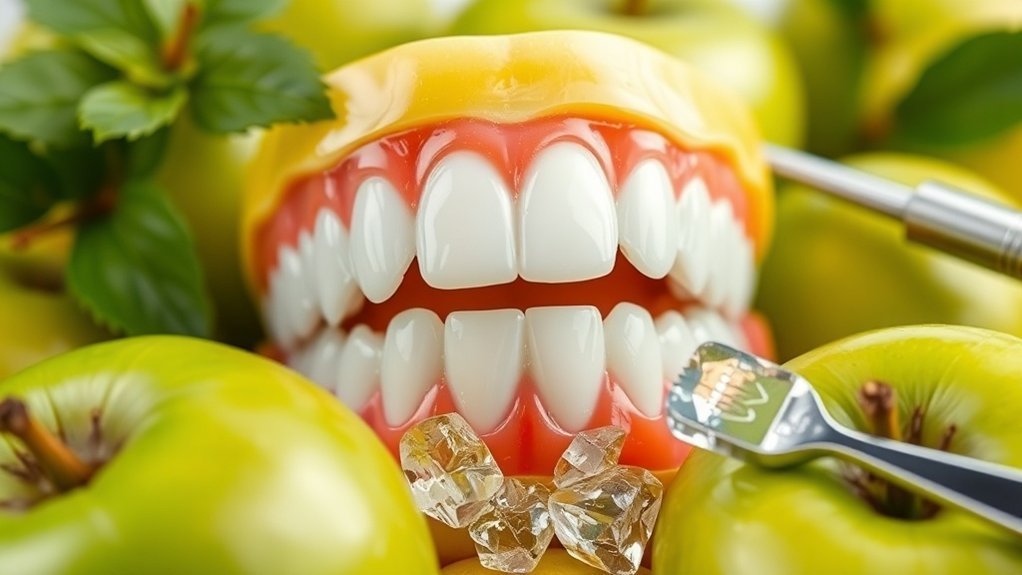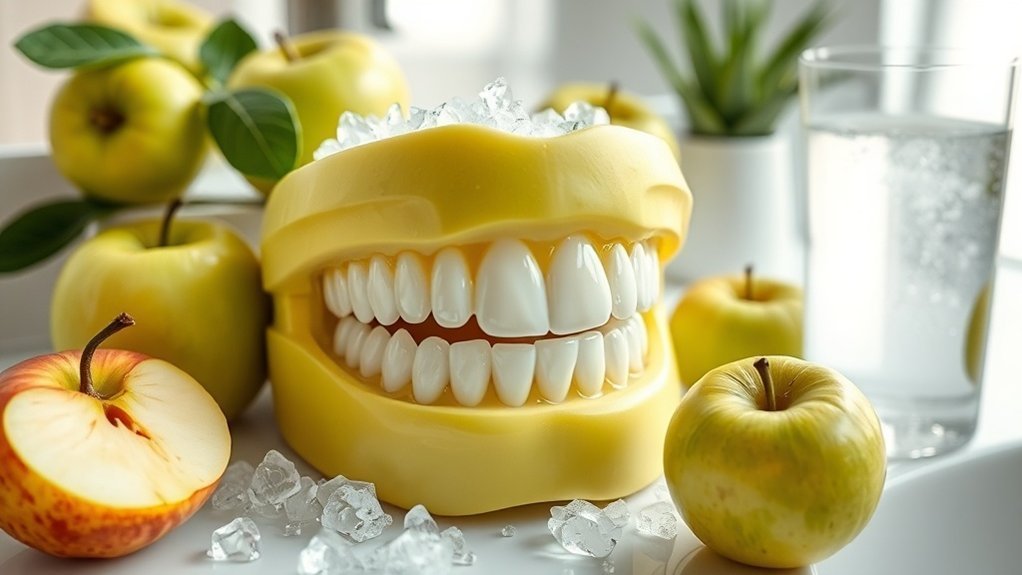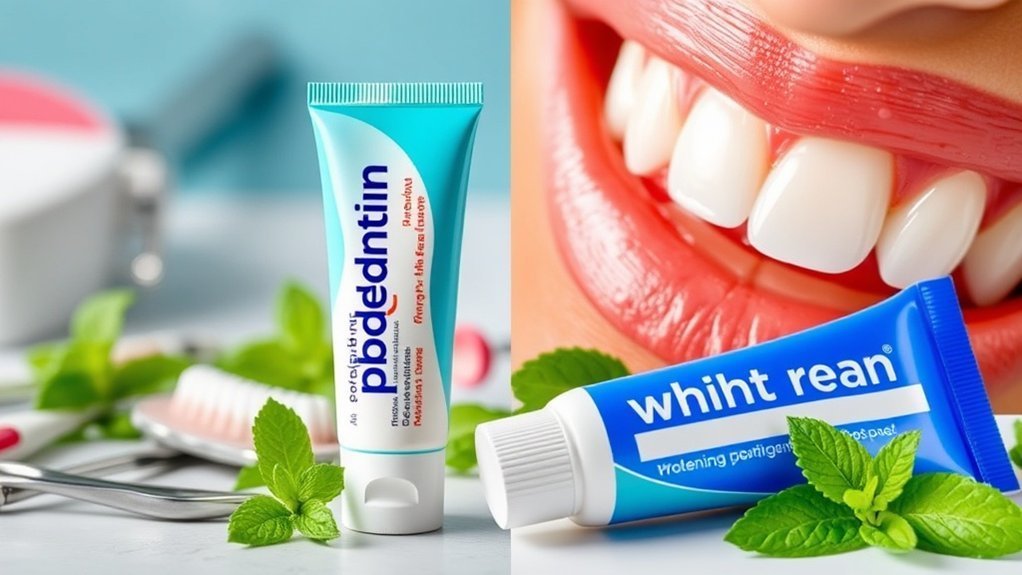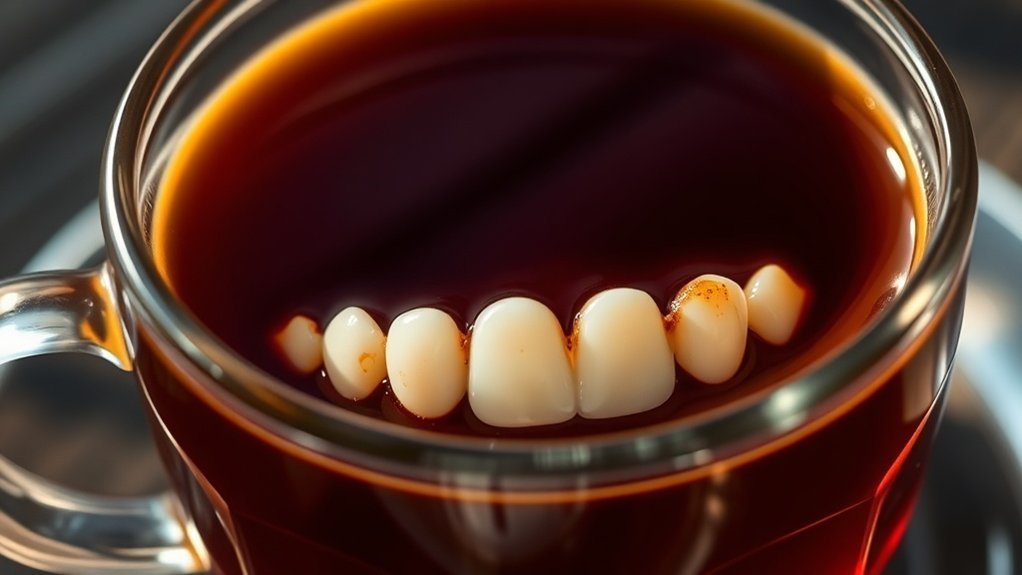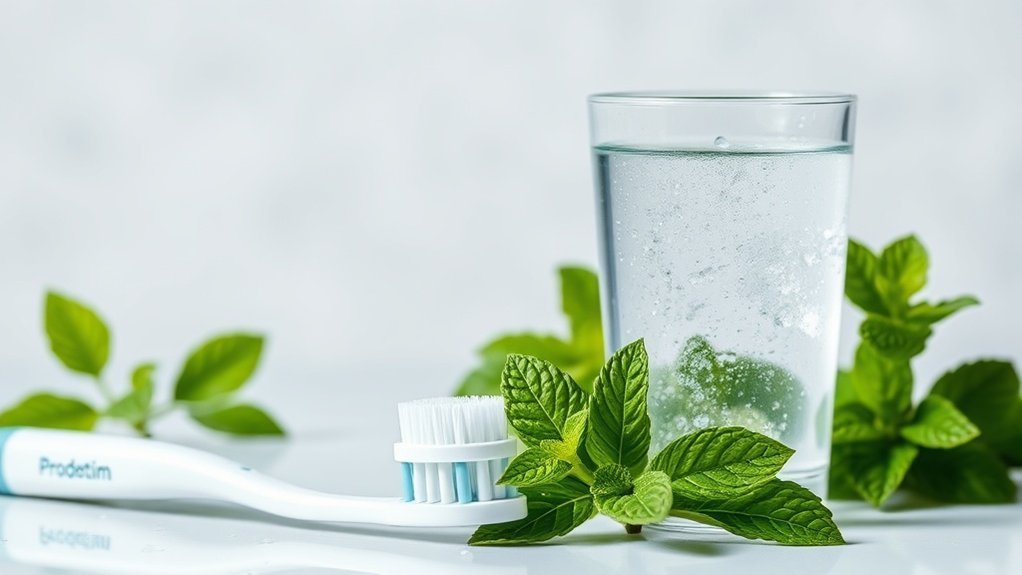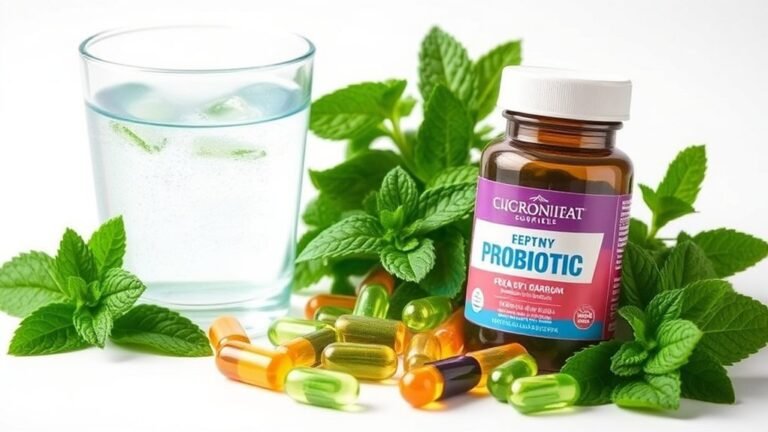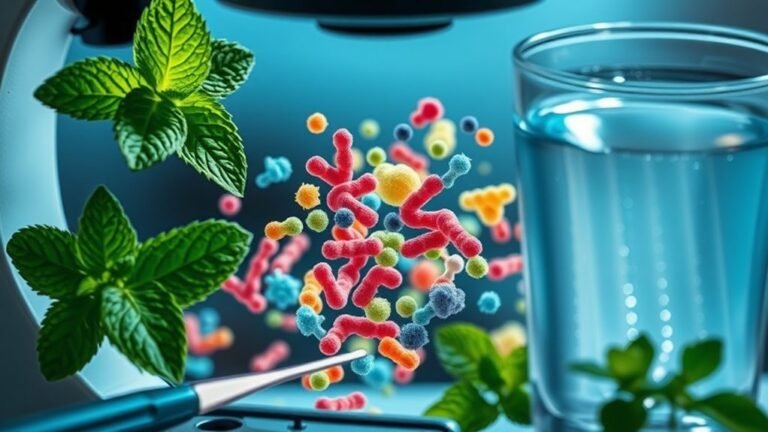What Role Does Malic Acid Play in Prodentim’s Whitening?
Malic acid plays an essential role in Prodentim’s whitening formula by gently dissolving surface stains and enhancing your overall oral health. Its natural origin allows for effective whitening without harsh chemicals, promoting enamel strength and fresh breath. Additionally, malic acid supports saliva production, which helps protect against decay and inflammation. This compound’s multifaceted benefits make it an appealing choice for those seeking a safer whitening option, and further insights await your exploration.
Key Takeaways
- Malic acid is a key ingredient in Prodentim’s whitening formula, enhancing the product’s effectiveness in removing surface stains.
- It gently exfoliates tooth enamel, promoting a brighter smile without harsh chemicals.
- The compound helps maintain pH balance in the mouth, crucial for overall oral health.
- Its natural properties act as an antioxidant, supporting gum health and reducing inflammation.
- Users report improved oral freshness and brightness due to the consistent use of Prodentim with malic acid.
Understanding Malic Acid: A Natural Compound
Malic acid, a naturally occurring organic compound, plays a significant role in various biological processes and is found in many fruits, particularly apples. As you explore its benefits, you’ll notice that malic acid serves as a key player in metabolic pathways, aiding in energy production and detoxification. Its presence in natural ingredients enhances the effectiveness of products like Prodentim’s whitening formula. Studies indicate that malic acid can help improve oral health by promoting saliva production, which in turn protects against tooth decay and enhances enamel strength. This natural compound’s ability to gently exfoliate and brighten teeth makes it a valuable addition to dental care. By understanding malic acid, you can appreciate its multifaceted benefits in maintaining ideal oral hygiene.
The Chemistry Behind Malic Acid
To understand malic acid’s role in Prodentim’s whitening, it’s essential to examine its chemical structure. This structure not only influences its effectiveness but also reveals how it interacts with stains on your teeth. Furthermore, recognizing its natural sources helps illustrate why malic acid is a valuable ingredient in dental care.
Chemical Structure Explained
Understanding malic acid’s chemical structure reveals its effectiveness in whitening products like Prodentim. This organic compound, classified as a dicarboxylic acid, features two carboxyl groups (-COOH) attached to a four-carbon backbone. The presence of these functional groups contributes to malic acid’s unique acidity and ability to interact with other molecules. Its molecular formula, C4H6O5, shows how malic acid can effectively dissolve surface stains without harsh chemicals, supporting the concept of chemical-free whitening. The structural characteristics allow it to penetrate enamel and facilitate the removal of discoloration, making it a valuable ingredient in dental care products. By harnessing malic acid’s properties, Prodentim provides a gentle yet effective whitening solution.
Whitening Mechanism Unveiled
The whitening mechanism of malic acid operates through a combination of chemical interactions and physical properties that effectively target surface stains on teeth. This organic compound acts by breaking down the molecular bonds of stains, facilitating their removal. Its acidic nature helps to enhance tooth enamel’s permeability, allowing for better penetration and subsequent stain removal.
| Mechanism | Effect |
|---|---|
| Acidic Properties | Breaks down stains |
| Enamel Interaction | Enhances permeability |
| pH Balance | Maintains oral health |
| Antioxidant | Reduces oxidative stress |
| Natural Source | Found in fruits |
Incorporating malic acid in teeth whitening products like Prodentim can greatly boost your stain removal efforts, leading to a brighter smile.
Natural Sources Identified
While many people may not realize it, malic acid is naturally abundant in various fruits, particularly apples, which are its most recognized source. This organic compound is essential not just for its tart flavor but also as a whitening ingredient in oral health products. Besides apples, you’ll find malic acid in pears, cherries, and grapes, all of which contribute to its prevalence in nature. Research indicates that malic acid aids in removing surface stains on teeth, enhancing their brightness and overall appearance. Its natural origin makes it a preferred choice for those seeking effective yet gentle whitening solutions. By incorporating these fruits into your diet, you can support your oral health while benefiting from the natural whitening properties of malic acid.
How Malic Acid Supports Teeth Whitening
Malic acid plays a pivotal role in teeth whitening due to its natural ability to break down organic stains on enamel. When you use products containing malic acid, you’re actively targeting discoloration caused by food, drinks, and lifestyle habits. This organic compound works by gently exfoliating the surface of your teeth, revealing a brighter, whiter smile underneath. The effectiveness of malic acid in promoting smile enhancement lies in its capacity to dissolve pigments without damaging the enamel, making it a safe option for regular use. Studies have shown that consistent application leads to noticeable improvements in tooth color, helping you achieve the radiant smile you desire. Incorporating malic acid into your dental care routine could greatly enhance your overall oral aesthetics.
Additional Benefits of Malic Acid for Oral Health
Malic acid not only acts as a natural teeth whitener but also plays an important role in maintaining pH balance in your mouth, which is essential for oral health. This acid can enhance gum health by reducing inflammation and promoting healing. By incorporating malic acid into your oral care routine, you can support both the aesthetic and functional aspects of your dental wellness.
Natural Teeth Whitener
As you explore natural options for teeth whitening, consider malic acid, a compound found in various fruits like apples, which has demonstrated promising effects in enhancing oral health. It’s not just a natural teeth whitener; it also plays a role in improving overall oral hygiene by helping to remove debris and reduce plaque buildup.
| Benefit | Description |
|---|---|
| Natural Teeth Whitener | Brightens enamel gently |
| Plaque Reduction | Helps minimize bacterial growth |
| Freshness | Promotes a clean mouth feel |
Incorporating malic acid into your dental routine can lead to whiter teeth and better oral hygiene, making it an attractive option for those seeking natural solutions.
Ph Balance Support
Maintaining an ideal pH balance in your mouth is essential for preventing dental issues, and malic acid can greatly contribute to this aspect of oral health. By helping to regulate the acidity levels in your mouth, malic acid promotes a balanced environment that supports beneficial oral bacteria. This balance is critical, as harmful bacteria thrive in overly acidic conditions, which can lead to cavities and gum disease. Additionally, malic acid can enhance breath freshness by reducing the presence of odor-causing bacteria. When your mouth’s pH is properly balanced, you’re not only protecting your teeth but also enjoying fresher breath throughout the day. Incorporating malic acid into your oral hygiene routine can thereby play a fundamental role in overall dental health.
Gum Health Improvement
While you might primarily associate malic acid with its role in whitening products, its benefits extend considerably to gum health. Research indicates that malic acid can help reduce the levels of harmful oral bacteria, which is essential for maintaining healthy gums. By creating an environment less hospitable for these bacteria, malic acid supports your gum health, potentially lowering the risk of gum disease. Additionally, its natural exfoliating properties can aid in removing dead cells from the gum surface, promoting better tissue regeneration. This dual action not only helps keep your gums clean but also enhances overall oral hygiene. So, when you think of malic acid, remember that it’s not just about whitening; it’s also about supporting your gum health effectively.
The Role of Malic Acid in Prodentim’s Formula
Malic acid plays an essential role in Prodentim’s whitening formula, enhancing both the product’s effectiveness and your oral health. It’s a naturally occurring compound known for its ability to gently exfoliate surface stains on your teeth, promoting a brighter smile. By improving oral wellness, malic acid not only whitens but also supports saliva production, which is important for maintaining a healthy mouth. Here’s a closer look at malic acid’s benefits in Prodentim:
| Benefit | Description | Impact on Oral Health |
|---|---|---|
| Stain Removal | Exfoliates surface stains | Whiter teeth |
| Saliva Production | Enhances saliva flow | Reduces decay risk |
| pH Balance | Helps maintain oral pH levels | Prevents acidic damage |
| Freshness | Provides a revitalizing taste | Enhances overall experience |
Comparing Malic Acid With Other Whitening Agents
Understanding the effectiveness of malic acid in Prodentim’s whitening formula is critical when comparing it to other whitening agents. Malic acid, derived from fruits, effectively targets coffee stains due to its natural exfoliating properties. Unlike harsher agents like hydrogen peroxide, which may cause sensitivity, malic acid offers a gentler approach while still delivering noticeable results. Studies indicate that malic acid can break down discoloration without damaging enamel, making it a safer choice for regular use. In contrast, some whitening agents may provide quick results but risk long-term dental health. This balance between efficacy and safety positions malic acid as a compelling option in the competitive landscape of teeth whitening. Your choice should reflect both immediate desires and long-term oral health.
User Experiences and Testimonials
Many users have shared their experiences with Prodentim’s whitening formula, highlighting the effectiveness of malic acid. Consumer reviews often emphasize how this ingredient not only whitens teeth but also helps neutralize breath odor. Users report a noticeable improvement in their oral freshness, attributing this to malic acid’s natural properties. Many mention that after consistent use, they’ve received compliments on their brighter smiles and fresher breath, reinforcing the formula’s dual benefits. Additionally, testimonials often note the absence of harsh side effects commonly associated with other whitening agents, making Prodentim a preferred choice for those seeking a gentler option. Overall, the positive feedback underscores malic acid’s key role in enhancing both the aesthetic and functional aspects of dental care.
Recommendations for Optimal Use of Prodentim
To maximize the benefits of Prodentim’s whitening formula, users should follow a few key recommendations. First, confirm consistent use by incorporating Prodentim into your daily dental routine; this enhances the effectiveness of malic acid in promoting whitening. Second, be mindful of your diet; avoid overly acidic or sugary foods that could compromise enamel protection. Third, consider using a soft-bristle toothbrush to minimize wear on your enamel while applying Prodentim. Additionally, rinse your mouth with water after using the product to help maintain a balanced oral environment. Finally, consult with your dentist regularly to monitor your progress and assure ideal enamel health. Following these guidelines will help you achieve the best results from Prodentim’s whitening capabilities.
Frequently Asked Questions
Is Malic Acid Safe for Sensitive Teeth?
Yes, malic acid’s generally safe for sensitive teeth. It can help with oral health, but if you have concerns, consult your dentist to confirm it suits your specific dental needs and sensitivity levels.
Can Malic Acid Cause Tooth Enamel Erosion?
Yes, malic acid can contribute to tooth enamel erosion if used excessively or improperly. You should monitor your usage and consult a dental professional to guarantee it doesn’t negatively affect your enamel health.
How Long Does It Take to See Results?
You’ll typically notice results within a few weeks of consistent use. Individual factors, like your starting tooth color and adherence to the regimen, can influence the timeline, so patience is essential for achieving ideal whitening effects.
Are There Any Side Effects of Using Prodentim?
Prodentim’s side effects aren’t as dramatic as a thunderstorm. You might experience mild sensitivity or irritation, but these are usually temporary. Always consult a dentist to guarantee it’s safe and right for your dental health.
Can Children Use Prodentim Containing Malic Acid?
Yes, children can use Prodentim containing malic acid, but it’s essential to consult a pediatric dentist first. They’ll provide guidance on appropriate usage and guarantee it’s safe for your child’s specific dental needs.
Conclusion
To sum up, malic acid plays a pivotal role in Prodentim’s whitening formula by effectively breaking down surface stains and promoting a brighter smile. Its unique properties not only enhance whitening but also support overall oral health. As you navigate your dental care routine, remember that a little malic acid can go a long way—like a knight in shining armor for your teeth. By incorporating Prodentim, you’re choosing a scientifically-backed approach to achieving a radiant smile.
